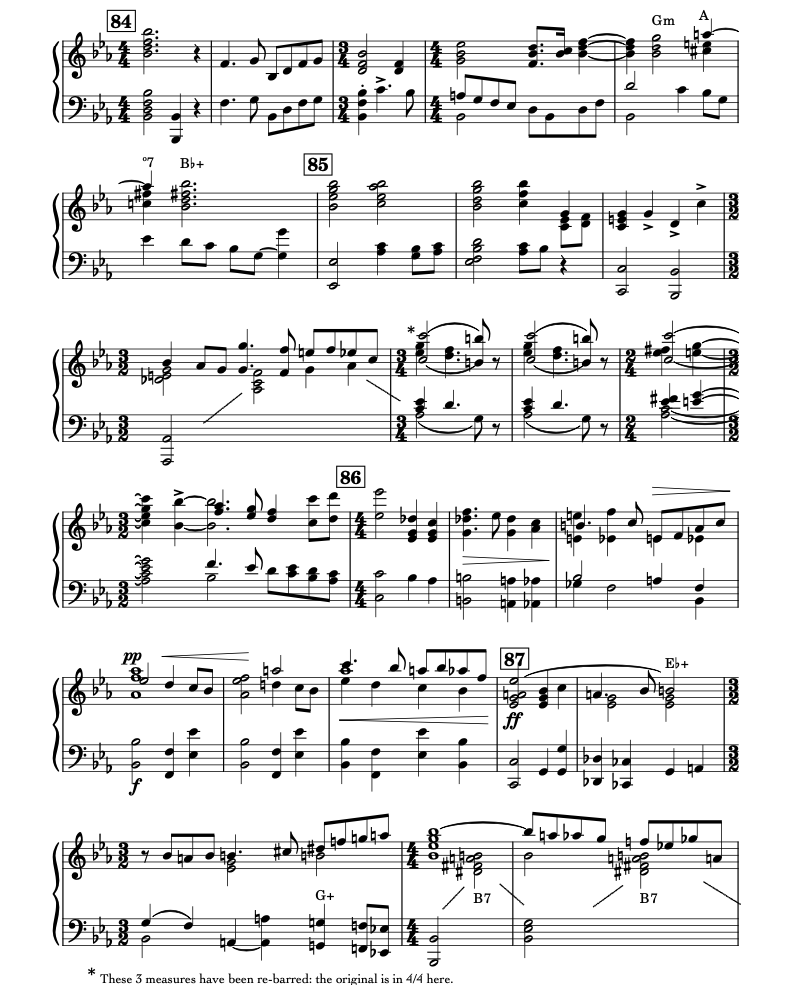A breakdown of the trouble-spots in the first movement, together with simplifications for several passages.
Mahler 8th: Help for the Rehearsal Pianist
Any pianist who undertakes to accompany rehearsals for Mahler's 8th Symphony has a doubly difficult task: playing a reduction of one of the most complex orchestral scores in all of classical music, while at the same time helping a choir grapple with some of the most challenging parts in the choral repertoire. Since it has fallen to me to accompany rehearsals for this extraordinary work on four different occasions, I feel uniquely qualified to offer some guidance to a pianist approaching it for the first time, and to share some simplifications and solutions that have worked for me.
Movement I: Ductore prævio!
The so-called Klavierauszug (piano reduction) in the published piano-vocal score for this work (Universal Edition) is quite literally unplayable. Actually, bars 1-4 are fine, but bar 5 would require three hands to execute as written. In trying to account for everything played by the orchestra, this reduction not infrequently spills onto three staves, sometimes onto four, and now and then onto five, so clearly one of the main considerations of any player is going to be what to leave out.
For a start, leave out any notes that require arpeggiation, such as at R1 [rehearsal number 1] -- arpeggiation not being a characteristic orchestral sonority. And wherever bass-notes have been written as grace-notes -- for example, at R3-2 [2 measures before rehearsal number 3] -- it is almost always preferable to leave something out rather than perform the awkward leaps and tempo-distorting hiccups thus suggested by the arranger! In the spot just mentioned, one might add a D and a B♮ above the A♭ in the RH chord so that the LH can play just the octave B♭. Alternatively, the 4 upper LH notes could be delayed until the 2nd beat of the bar. In most cases, the bass-note is what needs to be salvaged from these unfortunate misunderstandings. Tremolos should generally be avoided as well, as they savour too much of silent movie accompaniments!
Applying these principles to the passage at R4 will result in something like the following revision:
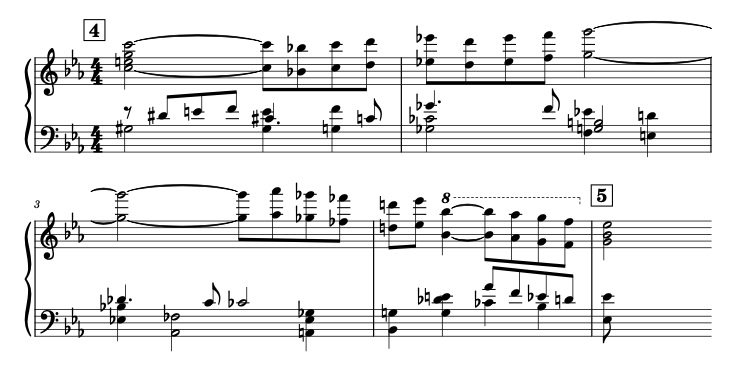
(It will be noted in the above that some pitches have been re-spelled enharmonically. Whether sharps or flats are easier to read in any given context is a highly subjective matter, so feel free to re-spell things as you see fit throughout the piece. Likewise with regard to cautionary accidentals: give yourself as many or as few as you personally need.)
My best advice about playing this piece generally is: "If in doubt, leave it out!" However, there are places where notes should actually be added to the piano score, either to assist the choral singers in finding or hanging onto particularly inscrutable pitches in their parts, or to supply notes that will be sung by the soloists. An example of the former is R6+4, where the dissonant 2nd Soprano notes G, F, and E♭should be added, at least in the early stages. An example of the latter is the first 3 bars of R10: there are seven solo lines here, so best not to rely on having the presence of mind to glance up, guess the clefs and read the pitches correctly from the solo staves: just write them in to the piano part! I suggest doing the same at R13-2, R14-5, and R21-3.
The choristers will bless you a thousand times if you also double them, until they are secure, in exposed places like R11-3 (Choir I), R12-4 (Bass 2s), and R22 (Choir I's exceedingly strange chords!).
Certain sections of this movement merit special preparation. I still remember, though it was 31 years ago, being in a practice-room "cramming" for my first rehearsal of this piece. I remember realizing that the passage from R42 to R44 was likely to give the singers a good deal of trouble, and since the piano part there contained nothing helpful, I took pains to identify the chords in the choral parts and write the chord-names into my score. It's fortunate that I did, because at the rehearsal, things fell apart at R42 and the choir needed me to play those chords accurately, confidently, and repeatedly!
It might be worth transferring the following into the spare empty measures in your score :
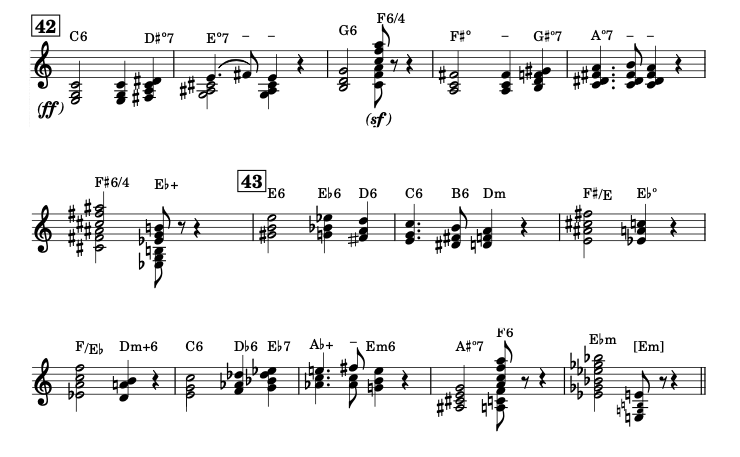
This brief but significant rewrite will assist the altos of both choirs:
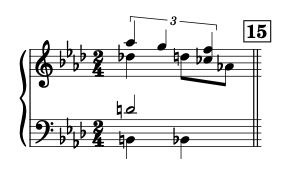
Rehearsal pianists can safely ignore everything between R23 and R36, but they must be prepared to play the passage at R37 convincingly, with full attention to the conductor, because the molto ritardando, the subdivided triplet at the end, and the choral entry that dovetails with it, require a fair bit of rehearsing. The following rewrite will make that possible:

At R45, the RH would be better off doubling the choir's pitches than rattling around on offbeat sixteenth-notes.
There are three bars just before R52 -- in the midst of the insanity of the double fugue -- that are very dissonant and difficult for the choir. It will help if you understand that the voicing of this passage, though split between the two choirs, is parallel thirds and faux-bourdon against chords of B♭, C minor, and F, as shown in the following reduction of the choral parts.

Yes, that really is how the choral parts go in this maelstrom of a fugue! It took me a while to enjoy the clashes of F♮ with F # and A♮ with A ♭! Likewise the way the music hurls itself from a chord of D♭ headlong into A Major coming into R53 takes some getting used to, but I suggest you throw yourself into these bits of rough-hewn harmony from the start, rather than shying away from them. It will help everyone to feel better about them if you play them with vigour and commitment!
The passage from R61 to R64 is one of those written on 3 and 4 staves in the score. I play it as shown here (including the marked tremolos, though it's against my religion!) There is, of course, a massive slowing-down through the end of this section.
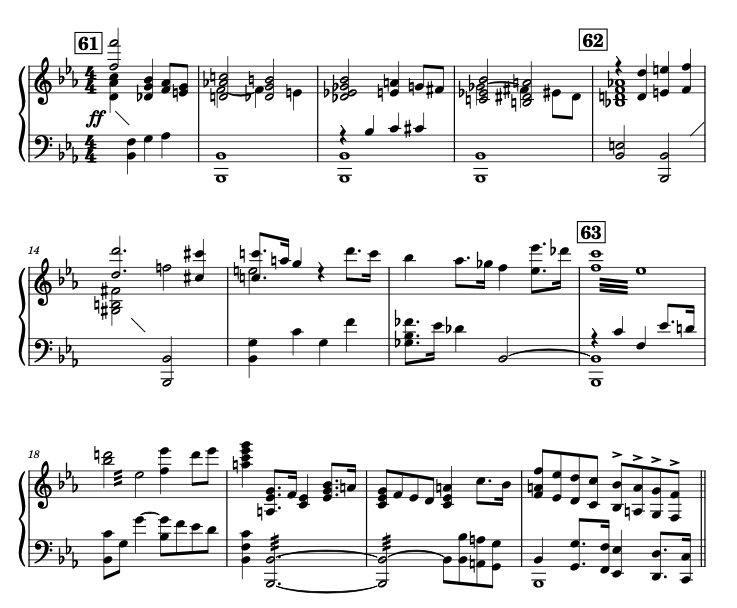
At R71-3, there is no need to play all the octaves and chords in the reduction. The following gives a perfectly good sense of both the harmony and the rhythmic activity in the orchestra, and allows you to glance up at the conductor, who will be trying to signal a subito piano half-way through the second bar! (That sub p is also the reason for the added breath-mark.)

At R76, the chords are written in flats and double-flats for the pianist, and in a mixture of sharps and flats for the choir. Pencilling in the chord-names A♭, E, B, and A will eliminate any confusion.
Here is a good simplification for R79-1, where the most important thing is not to play a lot of notes, but to make a lot of noise! (My prohibition on tremolos goes away again here.)
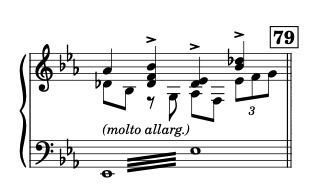
If you are accompanying the children's choir also, or for those rehearsals that the children attend, you will need a playable version of R82:

And finally, here is my reduction of the reduction of the entire "Gloria Patri" section.
